

|
Strasser Method for Shetlands
After dealing with severe founder and other
hoof problems, Catherine Crosado of the Duncree Shetland Pony Stud in
Christchurch, NZ, decided to change the way she managed her
Shetland ponies. She switched from traditional horsekeeping to
the Strasser
Method of
holistic
hoofcare and natural management.
The stud's large herd of Shetland ponies is now free of founder and other hoof
problems, and Catherine
says the ponies have never been healthier. She shares her experiences with Natural
Hoof. . .
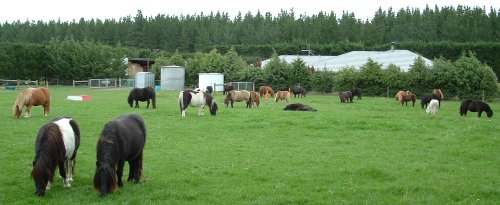
The Duncree Shetland Pony Stud herd
"We started using the Strasser trimming method and natural boarding back in
July 2004 after one of our mares Poppy foundered. (Poppy's story below). At the time our ponies
were living in small groups. We were strip grazing and locking up ponies at
night to keep them slim and avoid the dreaded founder.
My other ponies with hoof problems had separation in varying degrees, all
had contracted heels with the bars way too far forward and some underslung
heels.
None were as acute as Poppy, but one mare was in foal. She produced a
gorgeous foal which she carried while she was having some pretty big hoof abscesses. I was too
scared to give her any pain relief in case it harmed her unborn foal.
Nearly two years later, our ponies live in one large herd (27 in all) -
geldings, mares, young stock and mares with foals at foot. Oats are part of
their diet along with grass during the day and hay at night.
At first we
wondered how we could manage that many ponies in one group, but believe it
or not, it is easier. Our property has one large laneway down the centre
which allows us to rotate the paddocks and position the water troughs to
ensure there is a long walk to water.
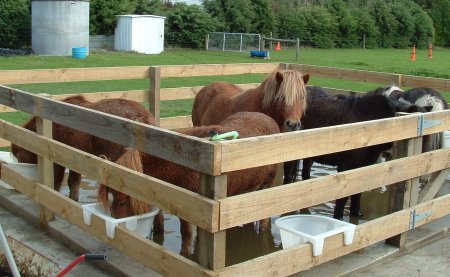
Oats and soaking time
We have built a large hoof bath that can
take up to eight ponies which means we can soak most of the ponies over 2 to
3 days. Soaking is quite a social activity as they get an extra feed of oats
while they soak.
The oats mixed with meadow chaff is
put out in feed bowls in another paddock which is locked off until feed time
ensuring another walk twice a day." [ed: The latest scientific research from Germany
shows that oats are the best feed for horses as oats have the most easily
digested protein of any grain. This will not only ensure best health and nutrition, but
prevent problems such as pot bellies, etc. However, a quality calcium magnesium
supplement must also be fed with oats as they are low in calcium.]
"Comparing Shetlands to other ponies and horses in regard to hoofcare and
management, firstly I'd say make sure you feed them. A 9hh Shetland gelding
with good bone weighs 250kg (I have a set of scales) and a shetland foal
will put on a kilo a day. More than people think. Secondly maintain the heels and toes at the correct height. The smaller
hooves are really tough.
The benefits of the Strasser Method far out-weigh any changes the human side of this
relationship has had to make:
- No pot bellies.
- No shaggy heavy coats.
- Increased fertility of our mares (all got in foal on the first service).
- Foals are happier and healthier in the large family group (they were born
into the herd).
- Improved mental health as the herd environment allows for play and social
interaction.
- Overall our ponies are healthier, happier, fitter and slimmer.
As for the humans, we are no longer afraid of founder. We have faced the
challenge of dealing with five of our ponies that have had hoof problems.
Strasser Hoofcare Professional Thorsten Kaiser has been immensely helpful and supportive and we now
feel confident that there will be no more hoof problems. And in case you
were wondering, yes we pick up all the manure twice a day."
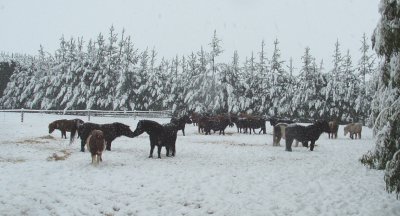
Playing in the snow
Extreme Weather
The Shetlands thrive just as well in extreme cold as any other weather in
Canterbury, NZ. The only hazard is having to break up the ice on the hoof bath
so they can get in it. In snowy conditions, it is still important to soak as dry
snow offers little moisture to the hooves. The ponies don't mind, but do
complain about the broken ice banging on their shins!
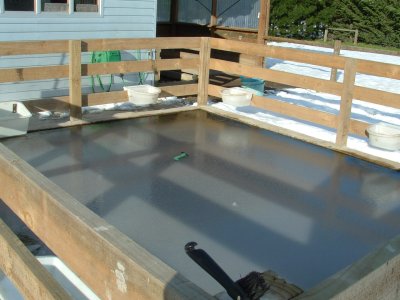
A hoofpick is frozen in the hoofbath
Poppy's Story
In 2004, Duncree Shetland Pony Stud mare Poppy was diagnosed with acute
laminitis. Catherine tells Natural Hoof Poppy's story of recovery using the Strasser Method.
"Thorsten Kaiser, SHP, described Poppy's founder as acute.
Our vet did x-ray her after nearly a month of treatment with bute and said
the best thing was to cut off her toes which were too long. We asked why
take off her toes and when we didn't get a logical answer, we decided to
call Thorsten and take Poppy to him in July, 2004.
She was pretty unwell for the first few weeks, but improved steadily after that. She came back home in mid
September, 2004. It was pretty scary having her back as we were new to the
process. But she's doing really well and treats the hoof
bath as her own private spa!
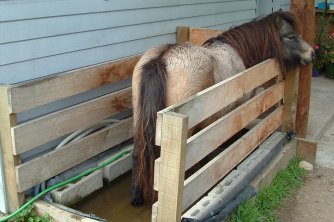
Poppy
For more information, contact Catherine at: imni@clear.net.nz
or visit the Stud's
website at: www.duncree.co.nz.
To find out more about the Strasser Method, visit the NZ Strasser
National Office website: www.strasserhoofcare.co.nz
or, visit the Natural Hoof article at: www.naturalhoof.co.nz/barefootmethod.html
Natural Hoof, 41 Block Road, Hikutaia, RD4, Paeroa, New Zealand.
Ph 07 862 7077, website: www.naturalhoof.co.nz, email: info@naturalhoof.co.nz
Home | Articles | Study Groups | Clinics-Events | Brag | Classifieds |
Order | Links


|
|
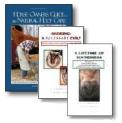
Recommended Reading

Available online
|






